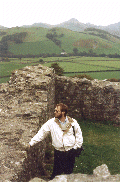



|
 |
 |
|
| writings || books || projects || madvertising || odds & ends || about || bio |
Art & Culture
Auld Lang Syne lessons learned from this profession
ok, I'm not the guy from SNL,
mostly true stories from my more "it's all about me"
Iím at -7.13/-7.33 on The
Political Compass. Where observations on the human condition take a trip with me
|
Published in the Columbia Daily Tribune 12 March 2006
Larry YoungAny artist who has the vision and self-discipline to place monumental works in over 50 locations around the country is an artist you have to take seriously. Any craftsman who has the skill and self-discipline to work with large amounts of molten metal at 2100 degrees is someone you have to respect. Any athlete who has the drive and self-discipline to win two medals in the Olympics is someone you have to admire.Columbian Larry Young is all three. Young is the sculptor behind the 17' tall monumental bronze titled Nexus on the grounds of Boone Hospital Center at the intersection of Old Highway 63 and Broadway. And, given the many awards for his work he has won, and the many commissions he has fulfilled, he is easily (and deservedly) one of Columbia's best-known artists. How did he accomplish this? Self-discipline, combined with artistic vision, craftsmanship, and not a little of the endurance he displayed when he won medals in the 1968 and 1972 Olympics in the sport of long-distance racewalking, the only American to have ever done so. You'll find all the details on his excellent website You'll also find a photo essay of how he constructed Nexus, along with images of some of his 40 other sculptures. What isn't on his website is how Larry Young did all this. It starts with his attitude about his art: "The transformation of clay into abstract life forms has intrigued me for the last thirty-five years. These life forms or images are vehicles through which my compositional networks are materialized. I am fascinated with the relationship of form and space and how they reside within an image. My objective is to create energy, movement, and a sense of monumentality into every image." Because of his grounding in the craftsmanship of casting bronze as a molder in the US Navy, he was able to approach making monumental sculptures in bronze with a thorough understanding of the materials that most artists lack. Most monumental bronze sculptors send their molds to a foundry to be cast - Young does it himself, and can therefore better control the finished product to his satisfaction. Following his military service, and while he was training for the Olympics, Young completed a degree in art at Columbia College. His early efforts to get his work before the public started there with a Columbia College gallery show in 1976. He did participate in some local art festivals and group shows, but found that these were in many ways more trouble than they were worth, due to the effort it takes to set up and take down a large sculpture show each day. However, he feels that art fairs are great for new artists, and advises "Take many opportunities to show your work. In the beginning the local art fairs are a great way to be able to sell directly to the public and build a following. If you are successful at that level, then you can begin to approach galleries and provide them evidence of your ability to sell work." This is the strategy which worked for him. For Young the big breakthrough came with the New York International Sculpture Fair in 1979 where he displayed one six foot bronze and about fifteen smaller pieces. This got him exposure on a national level, and brought connections with galleries who were also at the show. Since, he has done the New York Expo a number of times, which he considers to be his most successful venue for promoting his work. Another very successful means for marketing his work has been his website. These days, any serious artist should have as good a site as they can afford (either in their own time doing the work or in paying someone else to do it for them). This isn't so much for selling work directly - it's for getting the attention of collectors and galleries. It's also easier, cheaper, and likely more effective to provide a gallery with a url for them to check out than to send them a packet of slides. But it has to be done well, with the best quality images you can get. Larry Young's advice jibes with my experience running a gallery: "I recommend that people spend the time and money to build a high quality portfolio. Often your photographs are the only thing a gallery director will see prior to deciding whether to give you a chance, thus your photographs need to be able to 'say a lot'!" Coming from someone as successful in the field of art as Larry Young, it's advice worth heeding. |
|
contact me: jim@afineline.org |
all work © James T. Downey, 1993-present photos © Martha K. John, 1994-present |
site designed and maintained by: Coeurbois Graphic Design |